Lecture 18- THE SPREAD OF RELIGIONS -- Art of Byzantine Empire (540-843 CE), Part 2
1/31
There's no tags or description
Looks like no tags are added yet.
Name | Mastery | Learn | Test | Matching | Spaced |
|---|
No study sessions yet.
32 Terms
Byzantine Empire General Facts 540-843 CE
Using art to transcend the natural world, not depict the natural world
tried to capture the intangible world of the spirit
focused on light and color
didn’t focus on the illusionistic techniques like dark and shadow
reduces the natural world to only a few necessary descriptive forms
taking us out of physical space and into the mystical space of Christian tradition
naturalism and illusionism = less important in Christian time than they were in roman empire
timelessness and eternal symbols
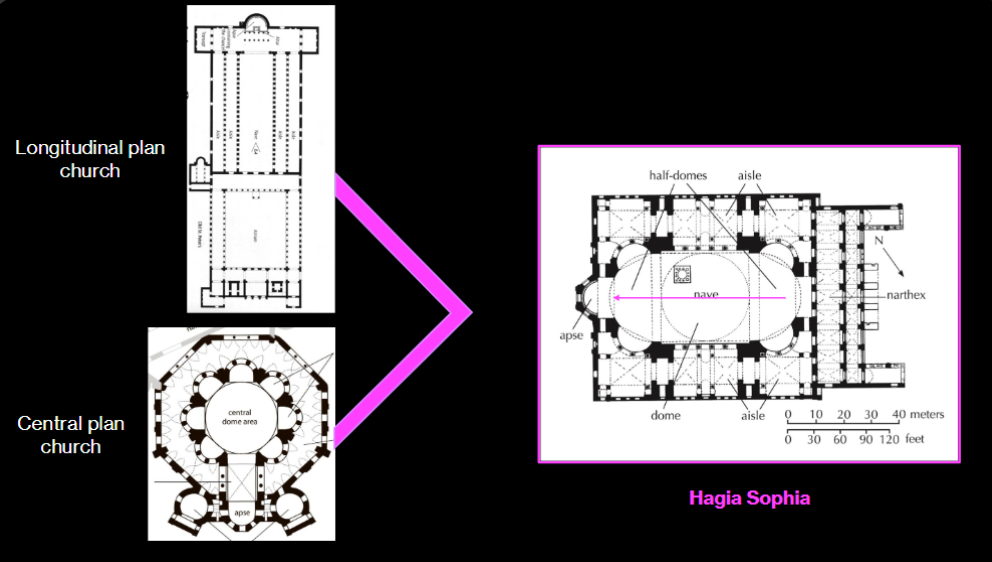
Hagia Sophia Cathedral, “Holy Wisdom” of God, Constantinople begun 532 CE
justinian’s “greatest architectural achievement”
hagia sophia = holy wisdom
cathedral dedicated to the holy wisdom of God
Cathedral is a name entitled to a church given by a bishop
Home base of the highest ranking bishop in the church in eastern christian world
Built very quickly
Isidore of Miletus and Anthemios
2 mathematicians designing this building
Pendentive
Half dome, pendentives surrounding the circular dome, half dome
integrated the spiritual and ceremonial needs of the orthodox church with the mixing of these 2 plans
Longitudinal plan church
saw in the basilicas
thrust of the building is in one direction towards the apse where the high altar is
Central plan church
the central dome = symbol of the dome in heaven could accommodate imperial processions
turned the church into an earthly heaven where the super celestial god dwells and walks around
Can walk around this space
Can commune w God
heavens opening to the worshippers below in the nave of the church to give them access to the celestial space
offers worshippers the promise that they can transcend the threshold that’s represented by the dome to go to heaven to commune with Go
Collapsed in 558 and reconstructed
Highly ornamented surfaces to create a “house for God”
Light gray marble floor with wave like pattern
grey stone was cut in a way called book matched
Space was divided by 4 bands of green stone set into stone
lower walls covered in revetment
Gold and silver in the tesserae
the hagia sophia tesserae was made by sandwiching gold or silver foil less than one micron thick between 2 pieces of glass
No figurative mosaics in Justinian’s church but repeated patterns of crosses to evoke the presence of God
Simple but unified looking interior
gray marble floor, lower wall revetments, and the gold mosaics w subtle patterns
creates an unbroken golden space
40 windows surrounding the base of the dome bc of the light that would stream from all the domes
Gives the dome a levitating effect
light and visual effects were important bc they felt those were needed to create a holy space
wanted to give a sense of otherworldliness thru the play of light and use of gold within the space
wanted to dematerialize the space to capture the sensory effects on the visitor
hagia sophia was not static
sense of dynanism generated by the interaction btwn the physical environment and things such as sight, sound, smell, the architectural space, and the viewer
dynamically and continually created by the changing effects of those diff interactions at diff times
designed to showcase the ceremonies that took place inside it
west side of church: large atrium and 2 large vestibules called narthexes
narthex (outer and inner): 2 sort of porches u had to walk thru to get to the entrances of the building
Imperial door: “central porch”— how emperor justinian and his royal entourage would enter
longitudinal aspect of the church (from the imperial door to the sanctuary)
facilitated these dramatic imperial entrances and the ensuing procession across this massive unfettered space where everyone gathered for the liturgy could admire the emperor and his entourage as they walked from the imperial door that only they were allowed to use to the most holy part of the church
done by justinian to set himself above both the ppl and the church
longitudinal pole and pole of the central dome creates a sort of dynamic tension that emphasizes that transcendent feeling of communing with God during the liturgy
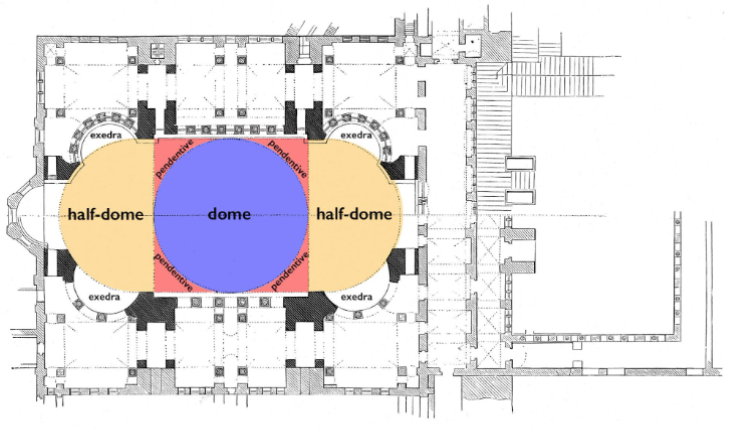
Pendentive
an architectural element in the shape of a triangular segment of a sphere, used to make the transition from a square room to a circular base for a dome
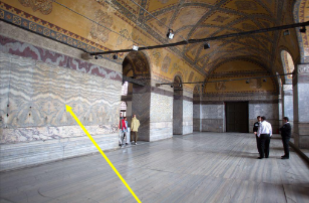
Revetment
in architecture, a decorative facing of stone, stucco, or other material covering a surface constructed of a less attractive material, such as brick or concrete
Iconoclasm
intentional religiously-motivated destruction of sacred images like icons
Icons
small portraits of Christ or the saints that were designed to serve as conduits to communing with the gods/saints and proxies for the divine presence
First Iconoclasm
726-787
initiated by Byzantine emperor Leo III
believe that the worship of icons violated the biblical commandment against making and worshipping graven images — led to formal ban on the creation and use of icons in the byzantine church
iconoclasts arguing that icons would lead to idol worship
Worship would lead to worshipping the image itself instead of the thing represented by the image
Second Iconoclasm
814-842
initiated by Leo the 5th
Driven by repetitive successive military setbacks→ God was dissatisfied with them
iconophiles
Monastery of St. Catherine’s Sinai, Egypt
Oldest inhabited, functioning monastery
holds many preserved icons
built between 548 and 565
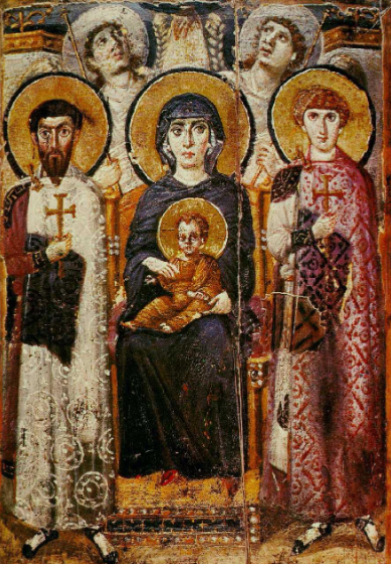
Icon of the Virgin and Child with Saints and Angels, 6th century, 6th century, Monastery of St. Catherine’s, Sinai, Egypt
Encaustic
Mary is holding baby jesus (center), to her right is saint theodore, and to her left is saint george and surrounded by angels looking up to the heavens
See the theme of the hand of god iconography
edge of a halo and a hand reaching down in this ray of light
hieratic style
we see a bit of naturalism in the faces and the body language of the angels, who def seem to be expressing emotion here as they react to the hand of god reaching down from the heavens— classicizing style that was mildly present
classicizing and hieratic style existing side by side
one of the oldest icons in the collection found at the monastery of st. catherine’s in Sinai, Egypt
Encaustic
pigment is mixed with hot wax to make this type of paint
Book Matched technique
plaques were cut across the veins and then arranged next to each other to create a symmetrical pattern that joined in a way that was reminiscent of water and of waves
tesserae
individual little tiles used to build mosaics
sanctuary
holiest part of the church and where the main altar would be located
Triumph of Orthodoxy
843
occurs after first and second iconoclasm
icons were formally reintroduced into orthodox practice
hieratic
style that’s characterized by formal, rigid, and highly stylized qualities, giving precedence to symbolic or spiritual significance over naturalism, illusionism, or emotional expression
Facts on the Vessels
gifts from elite helped the churches and shaped the liturgical space
christians sought to use luxurious objects whose material value and craftsmanship = suitable vessel for holding the bread and the wine
The Sion Treasure
hoard of over 70 objects that were buried in the 6th century in southern Turkey
contains liturgical objects
patens
censer
chalice
book covers
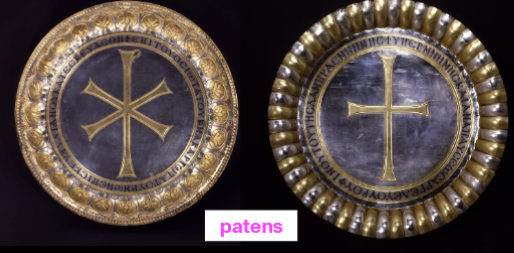
Paten- Sion Treasure
plate to hold the bread that would become the body of christ during the eucharistic ceremony
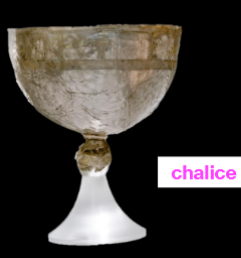
Chalice- Sion Treasure
liturgical vessel that was used to hold the wine that was turned into body or the blood of christ during the eucharist
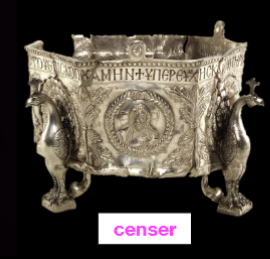
censer- sion treasure
originally would’ve had long chains attached to the top and been swung
would’ve contained smoldering incense and swung back and forth
the censer who was censing would walk around the church to spread the sweet smell of the incense around the church using a censer
embellished with repousse images of christ, st. peter, and st. paul
have little feet resembling peacocks
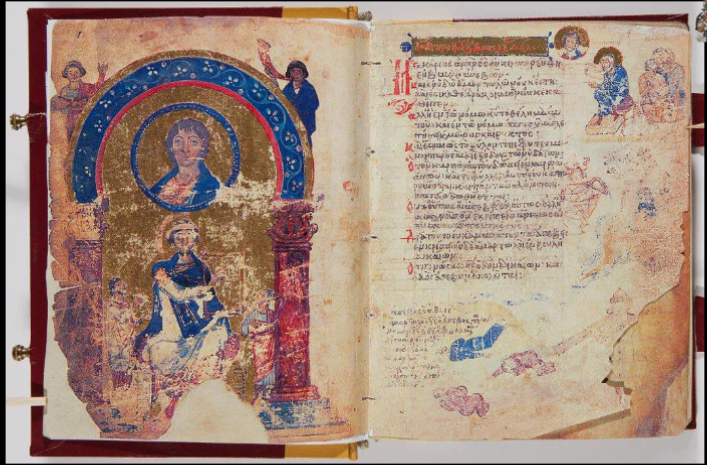
Cludov Psalter- Byzantine Manuscript
earliest surviving byzantine illustrated psalter
opens with an image of King David composing the Psalms
follows the “triumph of orthodoxy” that happened in 843 when icons were officially welcomed back into orthodox practice
made of 169 folios
225 marginal illustrations
in this particular psalter, the marginal illustrations were based on orthodox theologies and may even based on previous psalters
images are completely within the existing tradition, not considered unorthodox
cludov
name of someone who owned it at some point before it ended up in a museum
psalter
manuscript that contains the book of psalms
usually the first image is an image of King David (miniature)
in byzantine psalters, the image/images of king david were usually scenes from his life
for psalters in the west, it was usually an image of king david singing
psalms
very important bc they were the basics of daily christian worship in both western and eastern christian traditions
would be sung
canonical hours- monks would get up in the middle of night to sing the psalms
miniature
painted image in a manuscript
not always small
illuminated manuscript
describes any manuscript that has images in it
folio
describes the leaves of a manuscript book
manuscripts are numbered by folios rather than pages
each leaf is identified by a number
front and back of the leaf are distinguished by the terms recto and verso
ex: first page = folio one
ex: first page back side = folio one verso
ex: second page front side = folio two recto
marginal illustrations
images placed in the margins around the text
these are actual illustrations bc they do actually illustrate the content of the psalms
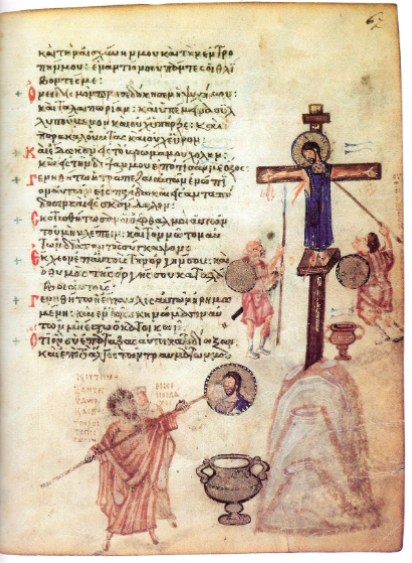
Image of the Crucifixion and iconoclasts whitewashing an icon of Christ, Khludov Psalter, Constantinople, soon after 843 CE (MS Khlud. D 129, State Historical Museum, Moscow), fol. 67r
“un-neutral” image in the cludov psalter
expresses the struggle back and forth over the validity of icons that had been part of the byzantine church for 100 years +
from the 67 folio recto
bottom left of the page
person in the front w crazy hair = reps the man who was the leading iconoclast during the 2nd iconoclasm named John the Grammarian
last iconoclastic patriarch of constantinople
person behind john is someone dressed as a bishop
above john is a label that says iconoclasts, indicating john and man dressed up as bishop as iconoclasts
right margin
crucifixion— shows the moment when the roman soldiers are offering christ to drink from the sponge that was saturated with wine
metaphorical text on the page compares mixing water and lime over Jesus’s face AKA whitewashing this icon of Christ with the crucifixion
draws a parallel btwn the crucifixion and iconoclasm
trying to say that iconoclasm was as evil as the crucifixion itself
also indicates that the manuscript was probs owned by an iconophile
iconophile
someone who was in support of having icons and using them within the liturgy and having them in as part of Byzantine practice
Byzantine Art after Iconoclasm
iconoclasm’s effect on byzantine art after the triumph of orthodoxy in 843:
restoration of icon veneration
strongly affirmed the use of images in devotion w/o equating them w idol worship
theological emphasis on the incarnation in art
theological justification for icons emphasized
focus on christ’s humanity
codification and standardization of artistic programs and iconography
ensures theological orthodoxy
created a coherent visual language that was seen in all types of byzantine art
icreases in production of icons and figurative mosaics
increased emphasison the role of art and architecture as a medium thru which to encounter the sacred
goal of continuing making art a window into the divine, a conduit to the divine presence rather than just telling a story— reinforced byzantine spirituality and the role of art as the medium thru which ppl could encounter the sacred